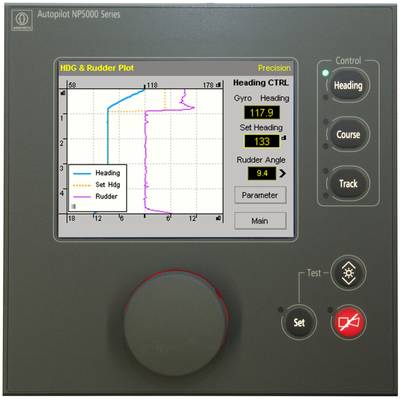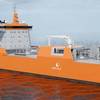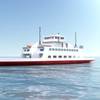NP 5000 Improves Fuel Consumption
As a consequence of recent IMO regulations, shipowners are requested to improve energy efficiency of their ships’ operation with regard to various factors that drive fuel consumption and emissions. The German navigation system manufacturer Raytheon Anschütz addresses these requirements with their newly developed autopilot series NP 5000.
As one of the first customers, the US-based Overseas Shipholding Group (OSG) has contracted Raytheon Anschütz for retrofitting existing autopilot systems on their fleet of oil tankers with the newly developed Anschütz NautoPilot 5300. The first autopilot system was installed onboard “Overseas Fran” in October 2011.
“OSG are undertaking great efforts to increase energy efficiency onboard of their ships. The choice of our new adaptive autopilot system was influenced by considerations of saving fuel and thus reducing emissions”, says Olav Denker, Product Manager at Raytheon Anschütz. “With OSG, we have now had the chance to prove positive effects of NP 5000 on steering performance and fuel consumption in practice for the first time.”
NP 5000 helps optimizing rudder movements with its integrated ECO-Mode. In Eco-Mode, the autopilot automatically adapts to the current sea-state and weather. Instead keeping a heading with frequent rudder actions with high amplitudes, the rudder’s sensitivity to periodical yawing movements caused by roll and pitch is reduced. Subsequently less rudder action is required, which leads to lower levels of speed reduction and thus less fuel consumption.
The first voyage of “Overseas Fran” with NP 5000 was from Skagen to New York. To investigate the actual effect of NP 5000 on rudder steering, the heading and rudder plot of this voyage was compared with the results of the last voyage on the same route with the old autopilot system, under similar weather conditions during both voyages.
Capt. Dmitry Shatrov, Master of “Overseas Fran, explains: “We can see on our print-out that rudder movement is more economic and gentle with the new autopilot system.”
The effect of ECO-Mode is further supported by the new integrated heading and rudder plotter, which provides a graphical indication of heading changes and the resulting rudder angles. This graphic display instantaneously indicates the steering performance of the vessel due to the effects of changes to parameter settings such as rudder, counter rudder and yawing. The operator benefits from simplified adjustments of the autopilot’s settings to gain optimized steering performance, which further minimizes rudder action and thus increases fuel efficiency.
“The newly installed autopilot system has a user-friendly interface in which you can easily adjust autopilot functionality in the prevailing circumstances, weather condition and required steering accuracy. So that we can navigate the vessel more gently and economically, taking into consideration fuel savings and safety”, Capt. Shatrov concludes.
The relevance of optimized rudder movements for fuel savings has already been highlighted by IMO as a “best practice” for efficient ship operation when developing a Ship Energy Efficiency Management Plan (SEEMP). “Since we all know that less rudder movement significantly contributes to reduced fuel consumption and emissions, we have developed and implemented unique features such as the Eco-mode and the heading and rudder plotter into the new NP 5000 autopilot series”, Mr. Denker explains.
In addition to its fuel-saving potential, NP 5000 is also equipped with advanced functions for high precision course keeping, for example for safe navigation in challenging sea areas near coastlines and shallow sea areas, platforms or archipelagos. Besides heading control and track control the new autopilot features a course control mode. When steering in this mode, the autopilot automatically compensates for drift and keeps the vessel on the defined course over ground line. An optionally integrated acceleration monitor provides a warning if a pre-defined cross acceleration limit is exceeded. This helps to avoid damage to cargo or discomfort to passengers due to high acceleration stresses that might occur for example during a heading change at high speed.
The NautoPilot 5000 was launched beginning of 2011 as successor of the proven NautoPilot 2000 series. In total, Raytheon Anschütz supplies 800 autopilot systems each year to the worldwide shipping.











